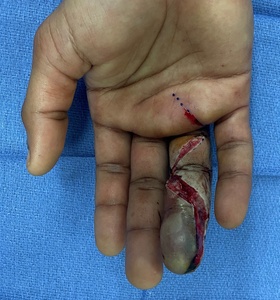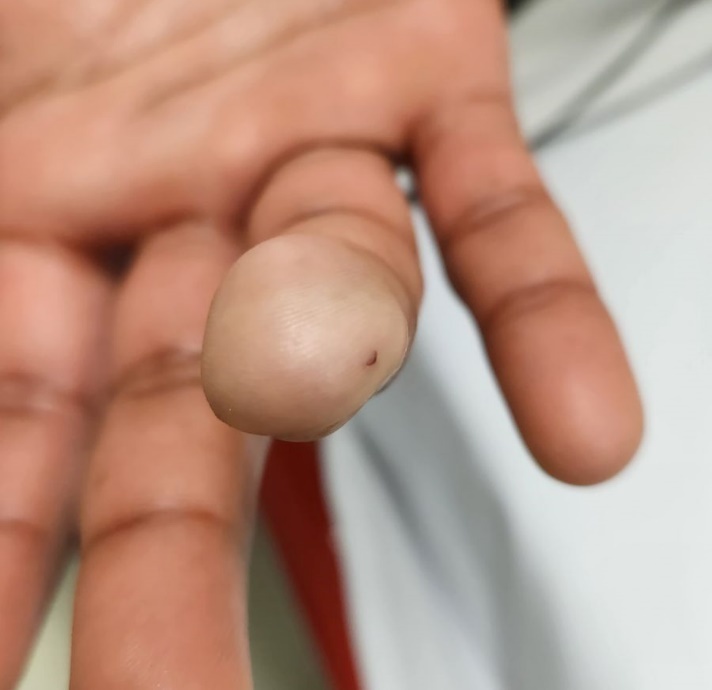Introduction
The prevalence of needlestick injuries in veterinary medicine is difficult to determine due to high rates of under-reporting. It is believed to be as high as 87 per cent, as demonstrated in one study surveying career exposures in American zoo veterinarians, with the majority being asymptomatic.1 The severity of injuries is dependent on the volume injected, the type of substance and the degree of bacterial contamination.2 Differently to human vaccination, animal vaccines usually are administered with a vaccine gun, inoculating multiple animals with a single needle.
We present an uncommon presentation of a Salmonella soft tissue infection to a digit following accidental self-inoculation with a poultry Salmonella vaccine.
Case
A 19-year-old male sustained a needlestick injury to his dominant right ring finger from a poultry vaccine gun inoculating a volume of approximately 0.5 mL. This vaccine included a water-based live attenuated vaccine against infectious bronchitis and an oil-based Salmonella Typhimurium vaccine. He developed progressive oedema and pain to the affected digit prompting him to present to the emergency department. He had no past medical history, used no regular medications and was a non-smoker.
On presentation, the patient was tachycardic at 110 beats per minute and afebrile. Upon clinical examination an entry site was noted at the ulnar tip of his right ring finger. The associated swelling extended from his finger tip to just proximal to his metacarpophalangeal joint. The digital pulp was pale but perfused and tender to palpation (Figure 1). Aside from the digital swelling the patient had no other cardinal signs of pyogenic flexor tenosynovitis. An X-ray was performed showing no retained foreign body and no underlying fracture. His initial white cell count was elevated at 13.5 × 109/L with neutrophils of 10.3 × 109/L and his C-reactive protein was normal at < 0.7 mg/L.
Following discussion with a toxicology specialist the case was referred to the plastic and hand surgery unit at our institution due to concerns regarding injection of an oil-based vaccine. The patient was admitted to hospital, had his limb strictly elevated and commenced on intravenous (IV) amoxicillin/clavulanic acid 1.2 g three times per day.
Twenty-four hours following the needlestick injury and despite being on IV antibiotics, the patient’s pain symptoms increased and he began to develop erythema on the affected finger. The volar aspect of the digit became more tense and painful to palpation. He was taken to the operating theatre for an initial exploration and debridement. The entry site was excised and sent for microscopy, culture and sensitivities. A Bruner’s style incision was then made extending from the pulp to the A1 pulley. The soft tissue was noted to be extensively inflamed with areas of fat necrosis and pus. The flexor sheath appeared to be clean, with no signs of flexor sheath infection. The incision was packed with betadine gauze and the patient returned to the ward postoperatively, continuing with regular dressing changes.
Salmonella species were cultured from all samples sent from the initial operation, including the entry site tissue, soft tissue and a wound swab. This was noted to be sensitive to ampicillin/amoxicillin, co-trimoxazole and ciprofloxacin. This was reviewed by the infectious disease specialists and the patient’s antibiotics were switched to IV ceftriaxone 2 g daily on day one postoperatively.
The patient underwent a repeat washout 48 hours later, finding further pulp necrosis and epidermolysis (Figure 2). Further wound swabs again cultured Salmonella. After extensive washout the incision was loosely closed with 4-0 monofilament. After showing significant improvement, he was discharged home with oral ciprofloxacin for a total of seven days.
Discussion
We present a rare case of a hand soft tissue infection potentially caused by the constituent of a live attenuated Salmonella species vaccine. Poultry Salmonella vaccine is usually composed of active constituents of living attenuated Salmonella Typhimurium (strain STM-1) within a freeze-dried pellet. It is designed to protect chickens from Salmonella and limit transmission to humans by preventing the consumption of contaminated food products.
Salmonella is a gram-negative rod commonly associated with disease affecting the gastrointestinal tract. Symptoms include diarrhoea, fever and abdominal pain potentially leading to severe dehydration. However, it is not commonly known how Salmonella infection affects other body systems such as the skin and soft tissue. Wound infections have been reported in the literature including a case affecting the sternum following acupuncture and in a patient with a lower limb necrotising soft tissue infection.3,4
In a case series from Turkey, four cases were reported of accidental human inoculation with Salmonella Enteritidis vaccines.5 Three of the cases required operative management, however no micro-organisms were grown in the reported tissue samples. Similar case reports have been published with accidental injection of other types of animal vaccine.
O’Neill and colleagues presented a case in which a combined bovine vaccine inoculation containing an oil-based emulsion caused swelling and pain non-responsive to initial conservative management.6 This case proceeded to surgical decompression and at one week required an amputation due to ongoing tissue necrosis. Cultures from fluid, pus and tissue over multiple operations also failed to grow any micro-organisms.
Live attenuated vaccines administered to animals tend to carry a much greater concentration of bacteria when compared to human vaccination (some 5–10 times more).7 Nonetheless, it is extremely rare for a human to contract an inoculated disease from these vaccines.8,9 Another possible avenue for infection from animal vaccine trauma is from skin flora or contaminants, such as animal waste, entering tissue when driven in by the needle.9 The use of vaccine guns to allow the inoculation of multiple animals increases the risk of needle contamination. Furthermore, significant local inflammation and tissue damage can be caused by adjuvant products contained within animal vaccines.5,6
Vaccine adjuvants function as immunomodulators, heightening and prolonging the immune response.8,10 However, the exact mechanism of action of some of these products is not fully understood despite their widespread use for decades. A commonly used adjuvant is an oil-based emulsion, which is frequently found in poultry vaccines. Mineral oils have been shown to significantly increase immediate and late locoregional complications, such as inflammation, phlegmons, tenosynovitis and necrosis.10 These findings have also been noted to occur despite early intervention, so ongoing monitoring is crucial.
Conclusion
While needlestick injuries in veterinary and agriculture workers are common, contracting a zoonotic infection from accidental inoculation of an animal vaccine is extremely rare. This case represents the unique situation of a culture-positive Salmonella infection following injection to a digit with a live attenuated vaccine. The resulting injury is likely caused by a combination of factors—the majority resulting from the tissue damage caused by the adjuvant components of the vaccine, with a smaller contribution from infection. It highlights the importance of understanding the components of an injected substance and the need for microbiological cultures to guide antibiotic choices.
Patient consent
Patients/guardians have given informed consent to the publication of images and/or data.
Conflict of interest
The authors have no conflicts of interest to disclose.
Funding declaration
The authors received no financial support for the research, authorship and/or publication of this article.
Revised: August 14, 2024 AEST



